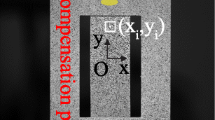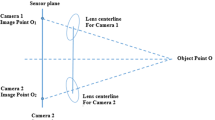Abstract
In-plane surface displacements, when measured with 2D Digital Image Correlation (2D-DIC), are very sensitive to out-of-plane displacement components. Any out-of-plane motion of the surface can pollute the measured field by introducing artificial displacements. These displacements are difficult to separate from the underlying response of the surface and thereby limit the application of 2D-DIC in inverse problems where the test specimen has significant motion in the out-of-plane direction. In the context of inverse problems, we propose to partially relax this condition of no out-of-plane motion in 2D-DIC. With this approach, only the out-of-plane rigid-body motion of the specimen surface, which is initially in-plane, needs to be avoided while the requirement of surface deformations to be primarily in-plane is essentially waived. Compensation, based on the pinhole camera model, for out-of-plane displacements of the surface in response to applied load is included within the error function of the minimization problem. The improvements in material parameter estimation, obtained by using the proposed compensation strategy, are demonstrated by an example. The proposed technique makes it possible to utilize 2D-DIC with a simple conventional lens for an increased number of inverse problems; and in the process avoiding the computational and experimental difficulties associated with 3D measurement methods as well as the high cost and magnification limitations of a telecentric lens.














Similar content being viewed by others
References
Chu TC, Ranson WF, Sutton MA, Peters WH (1985) Applications of digital image-correlation techniques to experimental mechanics. Exp Mech 25(3):232–244
Sutton MA, Yan JH, Tiwari V, Schreier HW, Orteu JJ (2008) The effect of out-of-plane motion on 2D and 3D digital image correlation measurements. Opt Lasers Eng 46(10):746–757
Sutton MA, Orteu JJ, Schreier HW (2009) Image correlation for shape, motion and deformation measurements. Springer, New York
Luo PF, Chao YJ, Sutton MA, Peters WH (1993) Accurate measurement of three-dimensional deformations in deformable and rigid bodies using computer vision. Exp Mech 33(2):123–132
Yoneyama S, Kitagawa A, Iwata S, Tani K, Kikuta H (2007) Bridge deflection measurement using digital image correlation. Exp Tech 31(1):34–40
Chasiotis I, Knauss WG (2002) A new microtensile tester for the study of MEMS materials with the aid of atomic force microscopy. Exp Mech 42(1):51–57
Hoefnagels JPM, Vossen BG, Tasan CC (2013) Electron micrographic digital image correlation: Method optimization and microstructural banding case study. In: Tom P (ed) Application of imaging techniques to mechanics of materials and structures, vol 4. Springer, New York, pp 71–77
Doumalin P, Bornert M (2000) Micromechanical applications of digital image correlation techniques. In: Jacquot P (ed) Interferometry in speckle light. Springer, New York, pp 67–74
Lord JD, Penn D, Whitehead P (2008) The application of digital image correlation for measuring residual stress by incremental hole drilling. Appl Mech Mater 13–14:65–73
Lubineau G (2008) Estimation of residual stresses in laminated composites using field measurements on a cracked sample. Compos Sci Technol 68(13):2761–2769
Poissant J, Barthelat F (2010) A novel “Subset Splitting” procedure for digital image correlation on discontinuous displacement fields. Exp Mech 50(3):353–364
Cho S, Chasiotis I, Friedmann TA, Sullivan JP (2005) Young’s modulus, Poisson’s ratio and failure properties of tetrahedral amorphous diamond-like carbon for MEMS devices. Micromech Microeng 15(4):728–735
Pan B, Qian K, Xie H, Asundi A (2009) Two-dimensional digital image correlation for in-plane displacement and strain measurement: a review. Meas Sci Technol 20(6):062001
Su C, Anand L (2003) A new digital image correlation algorithm for whole-field displacement measurement. Massachusetts Institute of Technology. http://hdl.handle.net/1721.1.3749. Accessed 31 Dec 2013
Hijazi A, Friedl A, Kähler CJ (2011) Influence of camera’s optical axis non-perpendicularity on measurement accuracy of two-dimensional digital image correlation. Jordan J Mech Ind Eng 5(4):373–382
Baere ID, Paepegem WV, Lammens N et al (2012) Experimentally induced errors in digital image correlation measurement of small strains with large gradients. In: Matikas TE, Aggelis DG (eds) Emerging technologies in non destructive testing V. CRC Press, Boca Raton, pp 441–446. doi:10.1201/b11837-80
Haddadi H, Belhabib S (2008) Use of rigid-body motion for the investigation and estimation of the measurement errors related to digital image correlation technique. Opt Lasers Eng 46(2):185–196
Tiwari V, Sutton MA, McNeill SR (2007) Assessment of high speed imaging systems for 2D and 3D deformation measurements: methodology development and validation. Exp Mech 47(4):561–579
Kashif SM, Toussaint E, Grediac M (2009) Optimization of a mechanical test on composite plates with the Virtual Fields Method. Struct Multidiscip Optim 38(1):71–82
Hild F, Roux S (2006) Digital image correlation: from displacement measurement to identification of elastic properties—a review. Strain 42(2):69–80
Pierron F, Grediac M (2012) The virtual fields method. Springer, New York
Florentin E, Lubineau G (2010) Identification of the parameters of an elastic material model using the constitutive equation gap method. Comput Mech 46(4):521–531
Moussawi A, Lubineau G, Florentin E, Blaysat B (2013) The constitutive compatibility method for identification of material parameters based on full-field measurements. Comput Methods Appl Mech Eng 265:1–14
Blaysat B, Florentin E, Lubineau G, Moussawi A (2012) Dissipation Gap Method for full-field measurement based identification of elasto-plastic material parameters. Int J Numer Methods Eng 91(7):685–704
Kashif SM (2007) Onto some numerical issues in the Virtual Fields Method: Optimization of testing configuration and piecewise construction of virtual fields. PhD thesis, Universite BLAISE PASCAL
Avril S, Bonnet M, Bretelle AS et al (2008) Overview of identification methods of mechanical parameters based on full-field measurements. Exp Mech 48(4):381–402
Nunes LCS, Castello DA, Matt CF et al (2007) Parameter estimation using digital image correlation and inverse problems. In: Alves M, Mattos HSC (eds) Mechanics of solids in Brazil, 1st edn. Brazilian society of mechanical sciences and engineering, Brazil, pp 433–443
Siddiqui MZ, Tariq F, Naz N (2011) Application of a two-step digital image correlation algorithm in determining Poisson’s ratio of metals and composites. International Astronautical Federation. http://www.iafastro.net/iac/archive/browse/IAC-11/C2/8/10236. Accessed 31 Dec 2013
Acknowledgments
The authors wish to thank Mr. Tasleem Baig and Dr. Sajid Mirza for approval and provision of facilities. We would further like to acknowledge the technical assistance extended by the R&D lab personnel where the experiments were conducted.
Author information
Authors and Affiliations
Corresponding author
Appendix
Appendix
Direct Estimation of Unknown Parameters
The two parameters extracted using inverse identification in this work are the Poisson’s ratio (PR) and coefficient of thermal expansion (CTE). Here we present a direct estimation of the unknown parameters in p to get a fair idea of the target values in our inverse problem. Since the material is nearly incompressible, the value of PR is expected to be very close to 0.5, hence no direct measurement is required.
The value of CTE however needs experimental evidence. For this purpose a temperature dependent CTE is measured for the same material using a 35 × 25 × 10 mm brick shape specimen. Two identical specimens are prepared for this purpose. Speckle pattern is applied on one specimen which is to be used for measuring temperature dependent strains using 2D-DIC; while the other is mounted with K-type thermocouple for precise temperature measurement. The specimens are placed in wooden boxes and covered with glass lids to avoid heat loss to the environment, Fig. 15. The wooden boxes containing the specimens are then put into an oven and heated. When a steady temperature of about 60 °C is achieved, the boxes are taken out and one of them is placed under a Nikon D90 camera, Fig. 16, while the other with thermocouple is just put next to this setup for continuous temperature measurement. Since the two blocks are of identical dimensions, and placed under same conditions, it is expected that they are at the same temperature.
By using time-lapse photography, images of the specimen surface are taken every minute until the temperature of the specimen stables at ambient temperature. The strains in the specimen are computed using OSM. Figure 17 shows the temperature and strain variation in the two specimens during test. The strain variation with respect to temperature and the estimated temperature dependent CTE are shown in Fig. 18. The temperature dependent CTE was calculated using equation (14)
Where CTE(T)i is the secant coefficient of thermal expansion, εi is the instantaneous strain and Ti and T0 are instantaneous and initial temperatures. Due to presence of noise in strain data, it was smoothed by fitting to a third degree polynomial before using equation (14). From this experiment the CTE at 32 °C is estimated to be about 120 μm/deg.
Rights and permissions
About this article
Cite this article
Siddiqui, M.Z., Ahmed, M.F. An Out-of-Plane Motion Compensation Strategy for Improving Material Parameter Estimation Accuracy with 2D Field Measurements. Exp Mech 54, 1259–1268 (2014). https://doi.org/10.1007/s11340-014-9880-4
Received:
Accepted:
Published:
Issue Date:
DOI: https://doi.org/10.1007/s11340-014-9880-4








